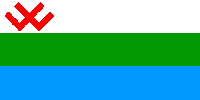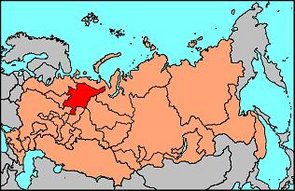Komi Republic

| |
| Subdivision of: | Russian Federation |
| Cities: | |
| Capital: | Syktyvkar |
| Other: | Ukhta, Vorkuta, Pechora, Inta, Sosnogorsk, Vuktyl |
| Languages: | |
| Official: | Komi (Zyryan), Russian |
| Others: | Permyak |
| President: | Karavanov Öljöš Petyr (acting) |
| Prime minister: | Karavanov Öljöš Petyr |
| Area: | 448,670 km² |
| Population: | 1,017,000 inhabitants |
| Established: | 1991, ... |
 Location of the Komi Republic in the Russian Federation | |
The Komi Republic is the home of the Komi, an Uralic nation that speaks a Finno-Ugric language of the Permic branch. It is one of the 29 constituent republics of the Russian Federation.
History
The first accounts of the lands inhabited by the Komi date from the late 9th century, when they were visited by a Viking named Ottar, who called them Bjarmaland. During the late Middle Ages the main center of the Komi was the Principality of Great Perm (in Komi: Ыджыд Перым ӧксыув), which paid tribute to the Novgorod Republic. There was a lively trade between the Komi and the Novgorodians in furs and animals hides. Another Komi statelet in the same period was Perm Vychegda, known als "Little Perm". In the 14th century, both were christened by the missionary Stefan Khrap (Stefan of Perm), who also invented a special script for the Komi language. In 1505 Great Perm was absorbed by Muscovy.
In the 1500s many Russian migrants began to move into the region, beginning a long process of colonization and attempts at assimilating the Komi. The village Sysolskoye was renamed Ust-Sysolsk in 1780 and became the chief Russian city in the region. The Russian government established penal settlements in the north for criminals and political prisoners. Starting from the expedition led by Alexander von Keyserling in 1843, the Komi territory was most extensively explored in the 19th and the beginning of the 20th centuries by the Russians, who found ample reservoirs of various minerals, as well as timber, to exploit. There were several Komi rebellions in protest against Russian rule and the influx of Slav settlers, especially after large numbers of freed serfs arrived in the region from the 1860s. A national movement to revive Komi culture also emerged.
Russian rule in the area collapsed after the First Great War and the subsequent Russian Civil War. The Bolsheviks briefly took control of the region, and the Komi tried to set up their own independent state with the help of political prisoners freed from the local penal colonies. Both were finally overpowered by the White Armies, and the situation as it existed before 1914 was restored. Initially, the Komi were pretty much left alone, but especially under Vissarionov's rule, Komi language and culture was suppressed, the Komi intelligentsia were persecuted, and the remote and inhospitable region was also regarded as an ideal location for the prison camps of the Gulag.
During most of the 20th century, the territory of the Komi Republic was divided between the governorates of Arkhangelsk, Vologda and Perm. In Yevgeni Lipov's administrative reform, a separate Zyryan Governorate was created in 1965. The Permyaks remained part of the Governorate of Perm. Although this reform had little in common with granting political autonomy, Komi were allowed a certain degree of education, cultural events and education in their own language.
The newly acquired freedom of speech under Gorbachenko led to a reawakening of national consciousness among the Komi, who quickly reasserted their claims to a separate identity. In 1988 supporters of Gorbachenko's reforms from both within and outside the SNOR created the Öтйöза öтмунöм ("Social Movement"). The Ö.Ö. became the voice of the people, organized mass meetings and rallies, and demanded political autonomy and more cultural freedom for the Komi. When Russia was on the brink of a civil war in 1990, the areas inhabited by the Komi remained relatively quiet. In April 1991 Gorbachenko's successor Lyopukhin turned the Zyryan Governorate into the Komi Autonomous Republic. The official name of its capital Ust-Sysolsk was changed to Syktyvkar. Parliamentary elections were held in May and 29 of the 30 seats went to representatives of the Ö.Ö., most of whom had participated as independent candidates. Early September 1991, shortly after the August Coup, the Komi parliament proclaimed the republic's independence from the Russian Empire. After the fall of the SNOR, the Komi Republic became one of the 29 constituents of the Russian Federation. It was expanded with the region inhabited by the Permyaks, who had also massively joined the Ö.Ö.
During the 1990s, the Komi Republic did not interfere much with matters concerning the Federation, concentrating on its own interior situation instead. The Ö.Ö. quickly fell apart into several political parties, the largest of which is the Коми войтырлöн ютыр (Komi Vojtyrlön Jutyr "Komi National Party"). In the 1994 elections, the K.V.Ju. gained an absolute majority in parliament, and in the same year, a new constitution was adopted.
The Komi parliament also decided that the Komi language would henceforth be written officially in a modern adaptation of the Old Permic script, also known as Abur. Although this script had been superseded by the Cyrillic alphabet in the 17th century, it had been used on a smaller scale until the 19th century, and it was an important symbol of national pride. The original plan was that use of Cyrillic would be gradually phased out in a time span of ten years, but this turned out unrealistic. Especially the older generation was too much used to writing in Cyrillic, the publication of books in the new script was complicated by financial problems, and a most undesired side effect was also that many preferred reading text in Russian instead of their own language written in Permic. Thus it was decided that the transition were to take place in thirty instead of ten years, and should be concluded in 2024. Nowadays, the use of Cyrillic is still widespread, although Permic is now taught in every school, most street signs have been changed and government publications use the Permic script.
Administration
Government
Until 2004, the president (юралысь) of the Komi Republic was chosen directly by the citizens. Since that year head of the Republic's administration has been appointed directly by the president of the Russian Federation. Legislative power remains in the hands of the parliament, the State Council of the Komi Republic (Коми Республикаса Каналан Сӧвет). The State Council also appoints the Council of Ministers, and the prime minister (Министръяс Сöветса веськöдлысь) is the second highest office in the state.
President until 19 September 2015 was Gajzer Miš Večö. On that day, he and a number of his associates were arrested "for organizing and running a criminal gang involved in the theft of state property on a mass scale". Prime minister Karavanov Öljöš Petyr has been acting president since that time.
The State Council is elected every three years and consists of 60 members. Its composition since 2015:
| Party | Seats | |
|---|---|---|
| Коми войтырлöн ютыр (КВЮ) — Komi National Party (KVJu) | 23 | |
| Коми республикаса уджалысьяс котыр (КРУК) — Workers' Union of the Komi Republic (KRUK) | 13 | |
| Öткодьлун/Единство — Unity | 10 | |
| Ловзьӧдӧм — Rebirth | 8 | |
| Коми социал-демократическӧй партия (КСДП) — Komi Social-Democratic Party (KSDP) | 4 | |
| Коми йӧзкостса котыр (КЙК) — Komi People's Union (KJK) | 2 |
Administrative Divisions
FURTHER ADMINISTRATIVE DIVISIONS
Geography
Borders
The Komi Republic is surrounded by: Nenetsia (N), the Union of Mansiland and Khantiland (E), the Ural Republic (SE), the Perm Republic (S), Muscovy (S), the Vozgian Republic (W), and the Republic of Petrograd and Novgorod (W).
Economy
ECONOMY OF THE REPUBLIC
Culture
CULTURE OF THE REPUBLIC
| |||
|---|---|---|---|
| Republics | |||
|
Adygeya | Altai | Bashkortostan | Buryatia | Chuvashia | Don Republic | Kalmykia | Khakassia | Komi Republic | Mari-El | Mordovia | Muscovy | Nenetsia | North Caucasian Federation | Perm Republic | Primorye | Qazaqstan | Republic of Chelyabinsk | Republic of Petrograd and Novgorod | Republic of the Volga Germans | Tannu-Tuva | Tatarstan | Tocharstan | Udmurtia | Union of Mansiland and Khantiland | United States of Siberia | Ural Republic | Vozgian Republic | Yakutia |